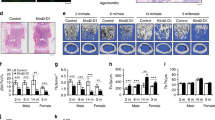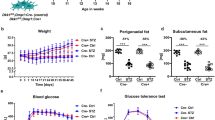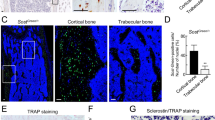Abstract
Bone formation by osteoblasts is essential for skeletal growth and remodeling. Fra-1 is a c-Fos-related protein belonging to the AP-1 family of transcription factors. Here we show that transgenic mice overexpressing Fra-1 in various organs develop a progressive increase in bone mass leading to osteosclerosis of the entire skeleton, which is due to a cell-autonomous increase in the number of mature osteoblasts. Moreover, osteoblast differentiation, but not proliferation, was enhanced and osteoclastogenesis was also elevated in vitro. These data indicate that, unlike c-Fos, which causes osteosarcomas, Fra-1 specifically enhances bone formation, which may be exploited to stimulate bone formation in pathological conditions.
This is a preview of subscription content, access via your institution
Access options
Subscribe to this journal
Receive 12 print issues and online access
$209.00 per year
only $17.42 per issue
Buy this article
- Purchase on Springer Link
- Instant access to full article PDF
Prices may be subject to local taxes which are calculated during checkout





Similar content being viewed by others
References
Erlebacher, A., Filvaroff, E.H., Gitelman, S.E. & Derynck, R. Toward a molecular understanding of skeletal development. Cell 80, 371–378 ( 1995).
Karsenty, G. The genetic transformation of bone biology. Genes Dev 13, 3037–3051 (1999).
Chambers, T.J. Regulation of the differentiation and function of osteoclasts. J Pathol., in press (2000).
Angel, P. & Karin, M. The role of Jun, Fos and the AP-1 complex in cell-proliferation and transformation. Biochim. Biophys. Acta 1072, 129–157 ( 1991).
McCabe, L.R. et al. Developmental expression and activities of specific fos and jun proteins are functionally related to osteoblast maturation: role of Fra- 2 and Jun D during differentiation. Endocrinology 137 , 4398–4408 (1996).
Grigoriadis, A.E., Wang, Z.Q. & Wagner, E.F. Fos and bone cell development: lessons from a nuclear oncogene. Trends Genet. 11, 436– 441 (1995).
Grigoriadis, A.E., Schellander, K., Wang, Z.Q. & Wagner, E.F. Osteoblasts are target cells for transformation in c-fos transgenic mice. J. Cell Biol. 122, 685– 701 (1993).
Johnson, R.S., Spiegelman, B.M. & Papaioannou, V. Pleiotropic effects of a null mutation in the c- fos proto-oncogene. Cell 71, 577– 586 (1992).
Wang, Z.Q. et al. Bone and haematopoietic defects in mice lacking c-fos. Nature 360, 741–745 ( 1992).
Grigoriadis, A.E. et al. c-Fos: a key regulator of osteoclast-macrophage lineage determination and bone remodeling. Science 266, 443– 448 (1994).
Cohen, D.R. & Curran, T. fra-1: a serum-inducible, cellular immediate-early gene that encodes a fos-related antigen. Mol. Cell Biol. 8, 2063–2069 (1988).
Cohen, D.R., Ferreira, P.C., Gentz, R., Franza, B.R., Jr. & Curran, T. The product of a fos-related gene, fra-1, binds cooperatively to the AP- 1 site with Jun: transcription factor AP-1 is comprised of multiple protein complexes . Genes Dev. 3, 173–184 (1989).
Matsuo, K. et al. Fosl1 is a transcriptional target of c-Fos during osteoclast differentiation. Nature Genet. 24, 184– 187 (2000).
Wisdon, R. & Verma, I.M. Transformation by Fos proteins requires a C-terminal transactivation domain. Mol. Cell Biol. 13, 7429–7438 (1993).
Owens, J.M., Matsuo, K., Nicholson, G.C., Wagner, E.F. & Chambers, T.J. Fra-1 potentiates osteoclastic differentiation in osteoclast-macrophage precursor cell lines. J. Cell Physiol. 179, 170–178 (1999).
Filvaroff, E. & Derynck, R. Bone remodelling: a signalling system for osteoclast regulation. Curr. Biol. 8, R679–682 (1998).
Kim, S.J. et al. Autoinduction of transforming growth factor β1 is mediated by the AP-1 complex. Mol. Cell Biol. 10, 1492–1497 (1990).
Kajimoto, Y. & Umayahara, Y. AP-1-like motif as a key to understanding the insulin-like growth factor I (IGF-I) gene regulation. Endocr. J. 45, 1–12 ( 1998).
Ducy, P. et al. Increased bone formation in osteocalcin-deficient mice. Nature 382, 448–452 ( 1996).
Ducy, P. et al. Leptin inhibits bone formation through a hypothalamic relay: a central control of bone mass. Cell 100, 197–207 (2000).
Ducy, P. et al. A Cbfa1-dependent genetic pathway controls bone formation beyond embryonic development. Genes Dev. 13, 1025 –1036 (1999).
Kuro-o, M. et al. Mutation of the mouse klotho gene leads to a syndrome resembling aging. Nature 390, 45– 51 (1997).
Li, B. et al. Mice deficient in Abl are osteoporotic and have defects in osteoblast maturation. Nature Genet 24, 304– 308 (2000).
Schreiber, M. et al. Structure and chromosomal assignment of the mouse fra-1 gene, and its exclusion as a candidate gene for oc (osteosclerosis). Oncogene 15, 1171–1178 (1997).
Schreiber, E., Matthias, P., Muller, M.M. & Schaffner, W. Rapid detection of octamer binding proteins with ‘mini-extracts’, prepared from a small number of cells. Nucleic Acids Res. 17, 6419 (1989).
Sabapathy, K. et al. JNK2 is required for efficient T-cell activation and apoptosis but not for normal lymphocyte development. Curr. Biol. 9, 116–125 (1999).
Plenk, H., Jr. in Techniques of biocompatibility testing, Vol. 1 (ed. Williams, D.F.) 35–81 (CRC Press, Boca Raton Florida, 1986).
Recker, R.R. Bone histomorphometry: techniques and interpretation (CRC Press, Boca Raton Florida, 1983).
Parfitt, A.M. et al. Bone histomorphometry: standardization of nomenclature, symbols, and units. Report of the ASBMR Histomorphometry Nomenclature Committee. J. Bone Miner. Res. 2, 595–610 (1987).
Kratochwil, K. et al. Retrovirus-induced insertional mutation in Mov13 mice affects collagen I expression in a tissue-specific manner. Cell 57, 807–816 ( 1989).
Acknowledgements
We thank K. Kratochwil for his generous help with kidney capsule transplantation experiments, and D. Lallemand, M. Yaniv and G. Karsenty for providing antibodies. We also thank G. Christofori, A. Grigoriadis and M. Cotten for critical reading of the manuscript. This work was supported by a Marie-Curie-Fellowship from the European Community to W.J. (ERBFMBICT961780) and a TMR postdoctoral stipend to J.P.D. (ERBFMRX CT960044). This work was partially supported by the Austrian Science Foundation (S07406-MOB) and the Austrian Industrial Research Promotion Fund.
Author information
Authors and Affiliations
Corresponding author
Rights and permissions
About this article
Cite this article
Jochum, W., David, JP., Elliott, C. et al. Increased bone formation and osteosclerosis in mice overexpressing the transcription factor Fra-1. Nat Med 6, 980–984 (2000). https://doi.org/10.1038/79676
Received:
Accepted:
Issue Date:
DOI: https://doi.org/10.1038/79676
This article is cited by
-
Identifying novel interactions of the colon-cancer related APC protein with Wnt-pathway nuclear transcription factors
Cancer Cell International (2022)
-
Fosl1 is vital to heart regeneration upon apex resection in adult Xenopus tropicalis
npj Regenerative Medicine (2021)
-
Mechanisms of bone development and repair
Nature Reviews Molecular Cell Biology (2020)
-
EGFR controls bone development by negatively regulating mTOR-signaling during osteoblast differentiation
Cell Death & Differentiation (2018)
-
Prognostic value from integrative analysis of transcription factors c-Jun and Fra-1 in oral squamous cell carcinoma: a multicenter cohort study
Scientific Reports (2017)



